
Newbyres Castle was a 16th-century tower house, in Gorebridge, Midlothian, Scotland, west of the main street. [1] The tower occupied a roughly triangular position, which was naturally defended by deeply worn water-courses. [2]

Newbyres Castle was a 16th-century tower house, in Gorebridge, Midlothian, Scotland, west of the main street. [1] The tower occupied a roughly triangular position, which was naturally defended by deeply worn water-courses. [2]
In 1543 Michael Borthwick of Glengelt acquired the land from James, Abbot of Newbattle, with the consent of the abbey's patroness, Mary, Queen of Scots, and built the property; the castle was purchased by Sir James Dundas of Arniston in 1624. [3]
By the early 20th century Newbyres was in an unsound, ruinous condition, and the local council demolished it in 1963 for reasons of 'public safety'. [4]

It had been an L-plan tower, the main block being 32.5 feet (9.9 m) by 24.0 feet (7.3 m). The wing was at the south angle, and measured 15.25 feet (4.65 m) by 5.0 feet (1.5 m). In the early 20th century the walls of the main block facing west and north were complete to the wall-head, the rest being fragmentary. There seems to have been a courtyard wall. The North East corner of the tower, standing to about 4.0 metres (13.1 ft), and a mound of overgrown rubble nearby are all that remain of Newbyres Castle. [2]
The building was rubble-built with freestone quoins; the tower was vaulted, rising from a basement course. There was a boldly projecting corbelled parapet equipped with rounds. There were numerous gun-loops, four at ground level and two at the second floor. The unusual cap-house to the projecting entrance wing collapsed in February 1881.
There was an armorial panel bearing the Borthwick arms.
The remaining structure is a scheduled monument, regarded as of national importance because it provides evidence and has the potential to provide further evidence for the study of the defensive architecture and domestic life of the minor gentry in mid-sixteenth-century Scotland. [5]
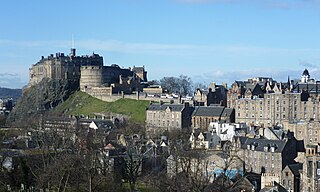
Edinburgh Castle is a historic castle in Edinburgh, Scotland. It stands on Castle Rock, which has been occupied by humans since at least the Iron Age. There has been a royal castle on the rock since the reign of Malcolm III in the 11th century, and the castle continued to be a royal residence until 1633. From the 15th century, the castle's residential role declined, and by the 17th century it was principally used as a military garrison. Its importance as a part of Scotland's national heritage was recognised increasingly from the early 19th century onwards, and various restoration programmes have been carried out over the past century and a half.

Borthwick Castle is one of the largest and best-preserved surviving medieval Scottish fortifications. It is located twelve miles (19 km) south-east of Edinburgh, to the east of the village of Borthwick, on a site protected on three sides by a steep fall in the ground. It was constructed in 1430 for Sir William Borthwick, from whom the castle takes its name,

York has, since Roman times, been defended by walls of one form or another. To this day, substantial portions of the walls remain, and York has more miles of intact wall than any other city in England. They are known variously as York City Walls, the Bar Walls and the Roman walls. The walls are generally 13 feet (4m) high and 6 feet (1.8m) wide. They are the longest town walls in England.

Greenknowe Tower is a 16th-century tower house, located just west of the village of Gordon, in the Scottish Borders. Although a roofless ruin, the stonework of the tower is well preserved, and represents a fine example of a later tower house, built more as a residence rather than as a place of defence. The building is located at NT639428, beside the A6105 road. It is a Scheduled Ancient Monument, and is in the care of Historic Scotland.

Appleby Castle is in the town of Appleby-in-Westmorland overlooking the River Eden. It consists of a 12th-century castle keep which is known as Caesar's Tower, and a mansion house. These, together with their associated buildings, are set in a courtyard surrounded by curtain walls. Caesar's Tower and the mansion house are each recorded in the National Heritage List for England as a designated Grade I listed building. The uninhabited parts of the castle are a scheduled ancient monument.

Bavelaw Castle is a historic house in the City of Edinburgh Council area, Scotland. It is north of Hare Hill in the Pentland Hills, four miles west of Penicuik, and two miles south of Balerno, above Threipmuir Reservoir. It was designated as a Category A listed building in 1971.

Mearns Castle is a 15th-century tower house in Newton Mearns, East Renfrewshire, south of Glasgow, Scotland. It is a Category A listed building. The castle has been restored and is now part of the Maxwell Mearns Castle Church. It also gives its name to nearby Mearns Castle High School.
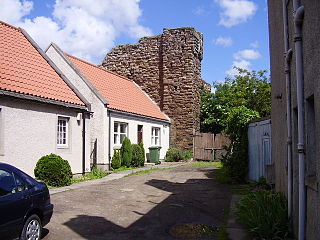
Tranent Tower is a ruined L-plan tower house dating from the 16th century, in Tranent, East Lothian, Scotland. The remains are protected as a scheduled monument.

Creich Castle is a ruined tower house near Creich, Fife, Scotland. The tower house and its associated buildings is a scheduled monument. There is a mention of a castle on the property in the 13th century, but it is uncertain what relationship that has to the existing structures. There is documentary evidence of a tower in 1553, but the existing structure either postdates that or has been heavily remodeled, judging by its architectural style.

Drochil Castle is a ruined castle in the Scottish Borders. It is located above the Lyne Water, 10 kilometres (6.2 mi) north-west of Peebles, and 8 kilometres (5.0 mi) south of West Linton.

Dally Castle is a ruined 13th-century stone motte-and-bailey fortress in Northumberland, and one of the first hall houses in Northumberland. It lies 5 miles (8.0 km) west of Bellingham Castle, and 4 miles (6.4 km) west of Bellingham on the Chirdon Burn, a tributary of the North Tyne. Dally Castle House was built in the 18th century next to the castle. Across the road lies a small flour mill used to grind wheat during the Napoleonic War.

The architecture of Scotland in the Middle Ages includes all building within the modern borders of Scotland, between the departure of the Romans from Northern Britain in the early fifth century and the adoption of the Renaissance in the early sixteenth century, and includes vernacular, ecclesiastical, royal, aristocratic and military constructions. The first surviving houses in Scotland go back 9500 years. There is evidence of different forms of stone and wooden houses exist and earthwork hill forts from the Iron Age. The arrival of the Romans led to the abandonment of many of these forts. After the departure of the Romans in the fifth century, there is evidence of the building of a series of smaller "nucleated" constructions sometimes utilizing major geographical features, as at Dunadd and Dumbarton. In the following centuries new forms of construction emerged throughout Scotland that would come to define the landscape.
Catcune Castle was a castle around 1 mile (1.6 km) south of Gorebridge, north of the Gore Water, in Midlothian, Scotland.

Findochty Castle is a ruined 16th century L-plan tower house, near Findochty, Moray, Scotland, about 2.5 miles (4.0 km) north-east of Buckie, and about 0.25 miles (0.4 km) from the sea to the north.
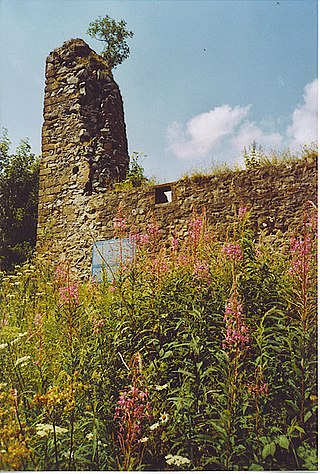
Lochwood Tower, also known as Lochwood Castle, is a ruined 16th-century L-plan tower house situated in Annandale about 6 miles (9.7 km) south of the town of Moffat in the modern county of Dumfries and Galloway, Scotland. It was the seat of the Clan Johnstone.
Dounreay Castle is a ruined 16th-century L-plan castle, about 8 miles (13 km) west of Thurso, Highland, Scotland, within the grounds of Dounreay Nuclear Power Development Establishment. It is also known as Dounreay House. The castle and its associated structures are a Scheduled Ancient Monument.
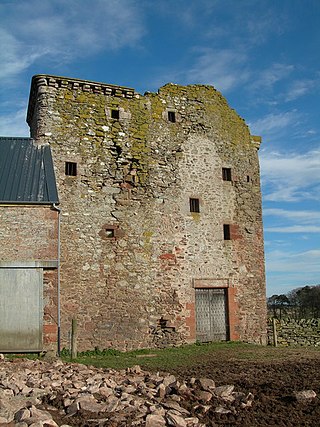
Evelaw Tower is a ruined 16th century tower house, about 2.5 miles (4.0 km) north west of Westruther, Scottish Borders, Scotland, and about 1.5 miles (2.4 km) east of Wedderlie, south of Eve Law.
Fulton Tower is a ruined 16th century tower house, about 4.5 miles (7.2 km) south west of Jedburgh, Scottish Borders, Scotland, and about 2 miles (3.2 km) south of Bedrule, east of the Rule Water.
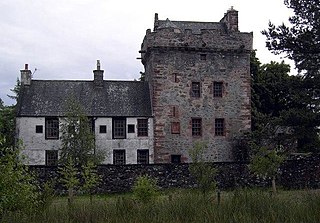
Hills Tower is a sixteenth-century square tower house, with an adjoining eighteenth-century wing, near Dumfries in Scotland. Originally built around 1527 for Edward Maxwell, who had purchased the estate from James Douglas of Drumlanrig, it was improved in the later sixteenth century by his grandson, also Edward Maxwell. In 1721, another Edward Maxwell had a two-storey Georgian wing added to the tower's east side, using stone taken from older buildings nearby, and incorporating armorial panels celebrating members of the Maxwell family.

Wallace's Tower is a ruined 16th-century L-plan tower house, about 3 miles (4.8 km) south west Kelso, Scottish Borders, Scotland, in Roxburgh, west of the River Teviot.